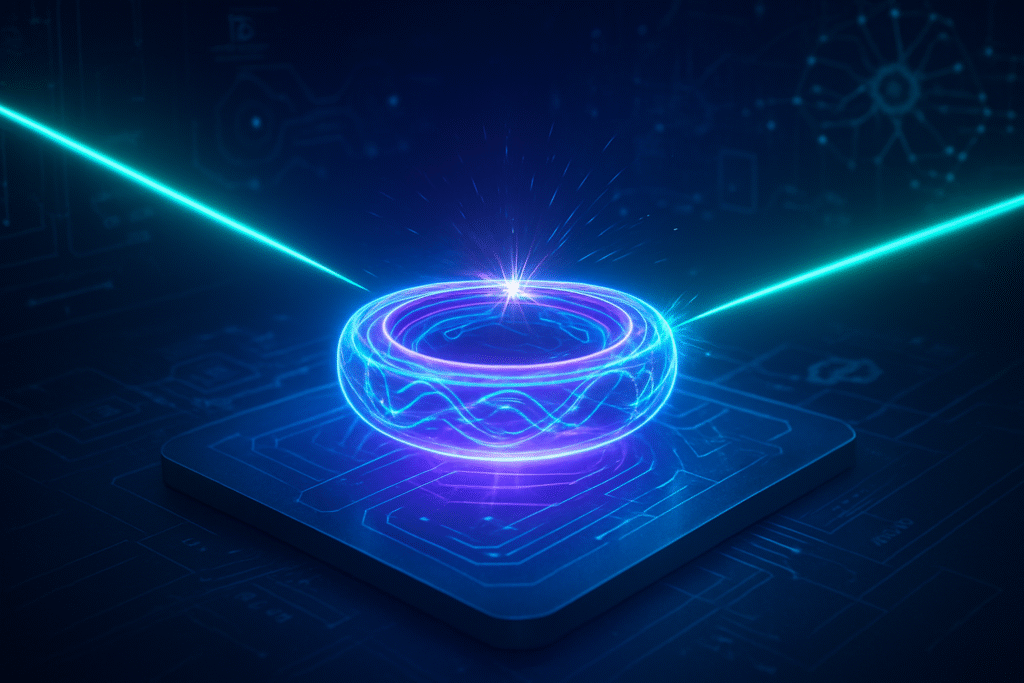Breakthrough in Photonics: Ultrafast Optical Gating Unlocks Instantaneous Readout from Microcavities

October 15, 2025 – In a significant leap forward for photonic technologies, scientists have unveiled a revolutionary method employing ultrafast optical gating in a lithium niobate microcavity, enabling the instantaneous up-conversion of intra-cavity fields. This groundbreaking development promises to fundamentally transform how information is extracted from high-finesse optical microcavities, overcoming long-standing limitations associated with slow readout protocols and paving the way for unprecedented advancements in quantum computing, high-speed sensing, and integrated photonics.
The core innovation lies in its ability to provide an "on-demand" snapshot of the optical field stored within a microcavity. Traditionally, the very nature of high-finesse cavities—designed to confine light for extended periods—makes rapid information retrieval a challenge. This new technique circumvents this bottleneck by leveraging nonlinear optics to convert stored light to a different, higher frequency, which can then be detected almost instantaneously. This capability is poised to unlock the full potential of microcavities, transitioning them from passive storage units to actively controllable and readable platforms critical for future technological paradigms.
The Mechanics of Instantaneous Up-Conversion: A Deep Dive
The technical prowess behind this breakthrough hinges on the unique properties of lithium niobate (LN) and the precise application of ultrafast optics. At the heart of the system is a high-quality (high-Q) microcavity crafted from thin-film lithium niobate, a material renowned for its exceptional second-order nonlinear optical coefficient (χ(2)) and broad optical transparency. These characteristics are vital, as they enable efficient nonlinear light-matter interactions within a confined space.
The process involves introducing a femtosecond optical "gate" pulse into the microcavity. This gate pulse, carefully tuned to a wavelength where the cavity mirrors are transparent, interacts with the intra-cavity field—the light stored within the microcavity. Through a nonlinear optical phenomenon known as sum-frequency generation (SFG), photons from the intra-cavity field combine with photons from the gate pulse within the lithium niobate. This interaction produces new photons with a frequency that is the sum of the two input frequencies, effectively "up-converting" the stored signal. Crucially, because the gate pulse is ultrafast (on the femtosecond scale), this up-conversion occurs nearly instantaneously, capturing the precise state of the intra-cavity field at that exact moment. The resulting upconverted signal then exits the cavity as a short, detectable pulse.
This method stands in stark contrast to conventional readout techniques, which often rely on waiting for the intra-cavity light to naturally decay or slowly couple out of the cavity. Such traditional approaches are inherently slow, often leading to distorted measurements when rapid readouts are attempted. The ultrafast gating technique bypasses these temporal constraints, offering a direct, time-resolved, and minimally perturbative probe of the intra-cavity state. Initial reactions from the AI research community and photonics experts have been overwhelmingly positive, highlighting its potential to enable real-time observation of transient phenomena and complex dynamics within optical cavities, a capability previously thought to be extremely challenging.
Reshaping the Landscape for Tech Innovators and Giants
This advancement in ultrafast optical gating is poised to create significant ripples across the tech industry, benefiting a diverse range of companies from established tech giants to agile startups. Companies heavily invested in quantum computing, such as IBM (NYSE: IBM), Google (NASDAQ: GOOGL) (Alphabet Inc.), and Microsoft (NASDAQ: MSFT), stand to gain immensely. The ability to rapidly and precisely read out quantum information stored in photonic microcavities is a critical component for scalable and fault-tolerant quantum computers, potentially accelerating the development of robust quantum processors and memory.
Beyond quantum applications, firms specializing in high-speed optical communication and sensing could also see a transformative impact. Companies like Cisco Systems (NASDAQ: CSCO), Lumentum Holdings (NASDAQ: LITE), and various LiDAR and optical sensor manufacturers could leverage this technology to develop next-generation sensors capable of unprecedented speed and accuracy. The instantaneous readout capability eliminates distortions associated with fast scanning in microcavity-based sensors, opening doors for more reliable and higher-bandwidth data acquisition in autonomous vehicles, medical imaging, and industrial monitoring.
The competitive landscape for major AI labs and photonics companies could shift dramatically. Those who can rapidly integrate this ultrafast gating technology into their existing research and development pipelines will secure a strategic advantage. Startups focusing on integrated photonics and quantum hardware are particularly well-positioned to disrupt markets by offering novel solutions that leverage this instantaneous information access. This development could lead to a new wave of innovation in chip-scale photonic devices, driving down costs and increasing the performance of optical systems across various sectors.
Wider Significance and the Future of AI
This breakthrough in ultrafast optical gating represents more than just a technical achievement; it signifies a crucial step in the broader evolution of AI and advanced computing. By enabling instantaneous access to intra-cavity fields, it fundamentally addresses a bottleneck in photonic information processing, a domain increasingly seen as vital for AI's future. The ability to rapidly manipulate and read quantum or classical optical states within microcavities aligns perfectly with the growing trend towards hybrid AI systems that integrate classical and quantum computing paradigms.
The impacts are wide-ranging. In quantum AI, it could significantly enhance the fidelity and speed of quantum state preparation and measurement, critical for training quantum neural networks and executing complex quantum algorithms. For classical AI, particularly in areas requiring high-bandwidth data processing, such as real-time inference at the edge or ultra-fast data center interconnects, this technology could unlock new levels of performance by facilitating quicker optical signal processing. Potential concerns, however, include the complexity of integrating such delicate optical systems into existing hardware architectures and the need for further miniaturization and power efficiency improvements for widespread commercial adoption.
Comparing this to previous AI milestones, this development resonates with breakthroughs in materials science and hardware acceleration that have historically fueled AI progress. Just as the advent of GPUs revolutionized deep learning, or specialized AI chips optimized inference, this photonic advancement could similarly unlock new computational capabilities by enabling faster and more efficient optical information handling. It underscores the continuous interplay between hardware innovation and AI's advancement, pushing the boundaries of what's possible in information processing.
The Horizon: Expected Developments and Applications
Looking ahead, the near-term developments will likely focus on refining the efficiency and scalability of ultrafast optical gating systems. Researchers will aim to increase the quantum efficiency of the up-conversion process, reduce the power requirements for the gate pulses, and integrate these lithium niobate microcavities with other photonic components on a chip. Expect to see demonstrations of this technology in increasingly complex quantum photonic circuits and advanced optical sensor prototypes within the next 12-18 months.
In the long term, the potential applications are vast and transformative. This technology could become a cornerstone for future quantum internet infrastructure, enabling rapid entanglement distribution and readout for quantum communication networks. It could also lead to novel architectures for optical neural networks, where instantaneous processing of optical signals could dramatically accelerate AI computations, particularly for tasks like image recognition and natural language processing. Furthermore, its application in biomedical imaging could allow for real-time, high-resolution diagnostics by providing instantaneous access to optical signals from biological samples.
However, several challenges need to be addressed. Miniaturization of the entire setup to achieve practical, chip-scale devices remains a significant hurdle. Ensuring robustness and stability in diverse operating environments, as well as developing cost-effective manufacturing processes for high-quality lithium niobate microcavities, are also critical. Experts predict that as these challenges are overcome, ultrafast optical gating will become an indispensable tool in the photonics toolkit, driving innovation in both classical and quantum information science.
A New Era of Photonic Control
In summary, the development of ultrafast optical gating in lithium niobate microcavities marks a pivotal moment in photonic engineering and its implications for AI. By enabling instantaneous up-conversion and readout of intra-cavity fields, scientists have effectively removed a major barrier to harnessing the full potential of high-finesse optical cavities. This breakthrough promises to accelerate advancements in quantum computing, high-speed sensing, and integrated photonics, offering unprecedented control over light-matter interactions.
This development's significance in AI history cannot be overstated; it represents a fundamental hardware innovation that will empower future generations of AI systems requiring ultra-fast, high-fidelity information processing. It underscores the critical role that interdisciplinary research—combining materials science, nonlinear optics, and quantum physics—plays in pushing the frontiers of artificial intelligence. As we move forward, the coming weeks and months will undoubtedly bring further research announcements detailing enhanced efficiencies, broader applications, and perhaps even early commercial prototypes that leverage this remarkable capability. The future of photonic AI looks brighter and faster than ever before.
This content is intended for informational purposes only and represents analysis of current AI developments.
TokenRing AI delivers enterprise-grade solutions for multi-agent AI workflow orchestration, AI-powered development tools, and seamless remote collaboration platforms.
For more information, visit https://www.tokenring.ai/.
More News
View More




Recent Quotes
View More
Quotes delayed at least 20 minutes.
By accessing this page, you agree to the Privacy Policy and Terms Of Service.